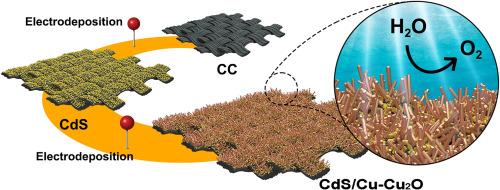碳布上Cu-Cu2O纳米棒- cds异质结构用于高效光电催化水分解
IF 8.3
2区 工程技术
Q1 CHEMISTRY, PHYSICAL
引用次数: 0
摘要
光电化学(PEC)水分解是实现可持续制氢、解决全球能源挑战的关键途径。本研究提出了一种创新的策略,通过电沉积技术在柔性碳布衬底上集成n型CdS和p型Cu-Cu2O纳米棒来制造高效的光阳极。该CdS/ Cu-Cu2O纳米复合材料在碳布界面建立了p-n异质结,显著提高了整体PEC性能。在LED照明(~ 80 mW/cm2)下,与可逆氢电极(RHE)相比,优化的光阳极在1.23 V下实现了令人印象深刻的8.7 mA/cm2的光电流密度,比未修饰的CdS光阳极提高了2.7倍。所观察到的光电化学(PEC)性能的增强可归因于CdS/ Cu-Cu2O界面的精心设计,这有利于优越的载流子动力学。这种改进源于表面工程和结构优化的协同结合,两者都显著影响电荷分离和转移的效率。重要的是,对表面形貌和缺陷密度的精确控制对于优化光电极的功能特性至关重要,从而确保优越的稳定性和性能。此外,CdS/ Cu-Cu2O光阳极表现出优异的光稳定性,在连续工作10小时内保持8.7 mA/cm2的稳定光电流密度。这项工作强调了碳布基材的定制表面和界面工程在提高光电化学(PEC)系统的效率和长期耐久性方面的关键作用。本文章由计算机程序翻译,如有差异,请以英文原文为准。

Cu–Cu2O Nanorod-CdS heterostructures on carbon cloth for efficient photoelectrocatalytic water splitting
Photoelectrochemical (PEC) water splitting represents a critical pathway toward sustainable hydrogen production, addressing global energy challenges. This study presents an innovative strategy to fabricate a highly efficient photoanode by integrating n-type CdS with p-type Cu–Cu2O nanorods on a flexible carbon cloth substrate using electrodeposition techniques. This CdS/Cu–Cu2O nanocomposite establishes a p-n heterojunction at the carbon cloth interface, significantly enhancing overall PEC performance. Under LED illumination (∼80 mW/cm2), the optimized photoanode achieved an impressive photocurrent density of 8.7 mA/cm2 at 1.23 V versus the reversible hydrogen electrode (RHE), representing a 2.7-fold improvement over the unmodified CdS photoanode. The observed enhancement in photoelectrochemical (PEC) performance can be attributed to the deliberate and meticulous design of the CdS/Cu–Cu2O interface, which facilitates superior charge carrier dynamics. This improvement arises from the synergistic combination of surface engineering and structural optimization, both of which significantly influence the efficiency of charge separation and transfer. Importantly, precise control over surface morphology and defect density is pivotal in optimizing the photoelectrode’s functional properties, ensuring superior stability and performance. Furthermore, the CdS/Cu–Cu2O photoanode demonstrated exceptional photostability, maintaining a steady photocurrent density of 8.7 mA/cm2 over 10 h of continuous operation. This work underscores the pivotal role of tailored surface and interfacial engineering of carbon cloth substrates in enhancing both the efficiency and the long-term durability of photoelectrochemical (PEC) systems.
求助全文
通过发布文献求助,成功后即可免费获取论文全文。
去求助
来源期刊

International Journal of Hydrogen Energy
工程技术-环境科学
CiteScore
13.50
自引率
25.00%
发文量
3502
审稿时长
60 days
期刊介绍:
The objective of the International Journal of Hydrogen Energy is to facilitate the exchange of new ideas, technological advancements, and research findings in the field of Hydrogen Energy among scientists and engineers worldwide. This journal showcases original research, both analytical and experimental, covering various aspects of Hydrogen Energy. These include production, storage, transmission, utilization, enabling technologies, environmental impact, economic considerations, and global perspectives on hydrogen and its carriers such as NH3, CH4, alcohols, etc.
The utilization aspect encompasses various methods such as thermochemical (combustion), photochemical, electrochemical (fuel cells), and nuclear conversion of hydrogen, hydrogen isotopes, and hydrogen carriers into thermal, mechanical, and electrical energies. The applications of these energies can be found in transportation (including aerospace), industrial, commercial, and residential sectors.
 求助内容:
求助内容: 应助结果提醒方式:
应助结果提醒方式:


